Maximize Your Fuel Economy—Part I, Outboards

While automobiles have gotten a lot more fuel efficient the last 20 years, improvements in gas outboard engines has proceed at a snail's pace. The new platforms introduced by each of the engine makers always improve fuel economy, but the percentage gains are relatively small.
Big gains in fuel economy for gas outboard-powered boats are not possible with current technology., unless your outboard engine is old and out of tune. But there are a number of things boat owners can do even with new engines to improve fuel mileage and boat range.
Limitations on Efficiency
There’s a finite amount of energy in a U.S. gallon of gasoline: the equivalent of 33.7 kiloWatts of electricity or 125,000 BTU of energy per gallon. (Diesel fuel has 138,700 BTU per gallon, according to the U.S. Dept of Transportation. Diesel fuel pack 11% more energy per gallon than gasoline.)
Not all of the stored energy of a given fuel, measured in BTU or kW-hr, can be converted to useful work by an any engine due to their method of combustion, the internal friction, and other factors. The measure of this is engine efficiency, often called thermal efficiency in the case of internal combustion engines.
Typically, gasoline four-stroke engine efficiency is about 25 to 30%. (Diesel engines can be as much as 40% to 50% efficient at converting fuel into work.) So, right out of the gate, converting gasoline to energy is an inefficient process no matter whose engine it is.
So, the question begs, what can a boat owner do to get more miles per gallon (MPG) out of a gas outboard?
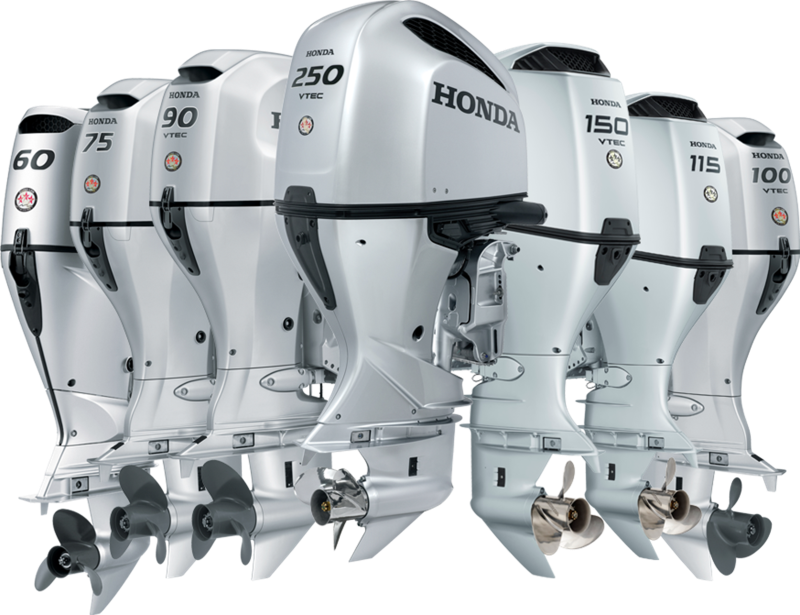
Honda’s was second in the industry to offer four stroke outboards and today has models up to 250 horsepower, with most of the larger engines based on the company’s well-known automotive engines and technology. (Honda Marine)
Slow Down to Stretch Fuel Dollars
Strategy #1 is to simply slow down.
If you go really slow, idle speed, you’ll squeeze out the highest mpg possible, but of course it may take you half the day just to get to that distant fishing spot or hidden beach, and the other half of the day just to get back.
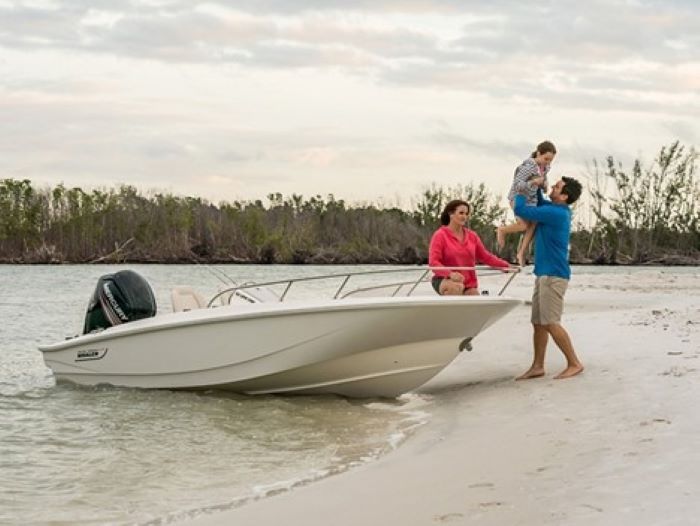
Smaller boats with smaller motors equal far less fuel use, naturally, but load capacity goes down accordingly. (Boston Whaler)
So, big savings in fuel economy means spending more time getting to a destination. You are spending dollars to save time. If you have an abundance of time, then you can save money on fuel by going slower.
Idle speed for most outboards is around 600 rpm, and depending on the size and design of the boat, the weight, the horsepower and the prop, speed will vary around 3 mph up to 6 mph. (At idle speed, it’s usually best to have the motors trimmed so that they’re pretty much vertical, straight up and down, so that the prop(s) push straight ahead, for best mileage.)
A Robalo R-250 we tested , for example, with twin Yamaha F150’s and three-blade 15.25 x 18 props got 3.4 mpg at 600 rpm and 3.1 mph. That was the best the twin engine setup delivered. If you are far from the fuel dock and hope to get there on the final fumes, idle speed is clearly the way to go.
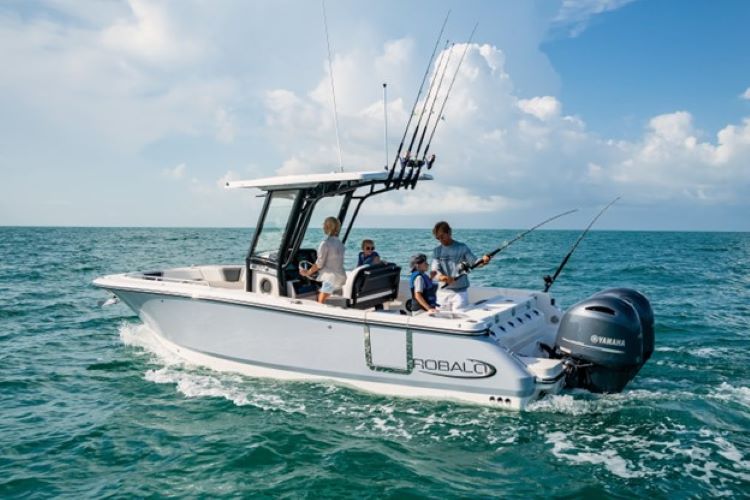
Trolling speeds provide excellent fuel economy with outboards. (Robalo Boats)
Displacement Speeds
The common boat culture in the the U.S. is to go fast whenever using an outboard-powered boat. But, since most outboard boats are on small lakes or rivers, how fast do you need to go to get to the other side, or to the destination?
Engine companies promote going fast because their customers want it, and it is also good business to make ever higher-horse powered engines. For example, Mercury's 600-hp engine cost over $80,000, plus rigging. Each. But boat owners must question how fast they really need to go, and how much horsepower that will take.
Why not slow down to displacement speeds, no matter what kind of boat is owned, and smell the great outdoors? Why not give your guests a pleasant ride, instead of a white-knuckled one?
The displacement speeds we are talking about, depending on the boat, are usually around 8-9 mph, but as high as 11-12 mph for pontoon boats. These are speeds that preceed the struggle to get over the vessel's bow wave, where virtually all boats go into a black hole of fuel consumption.
Fuel Consumption at Its Worst
Fuel economy in the vast majority of outboard powered planing boats is worst between 1500 and 3000 rpm, when the boat is trying to get on plane—the bow is high, the stern is low or squatting and the boat is pushing a huge wave. Most of the energy of the fuel is being used to dig a hole in the bow wave.
Once the boat goes “over the hump” the bow drops, the stern rises, and speed increases dramatically—sometimes doubling from 3000 to 3500 rpm., or from 3500 to 4000 rpm.
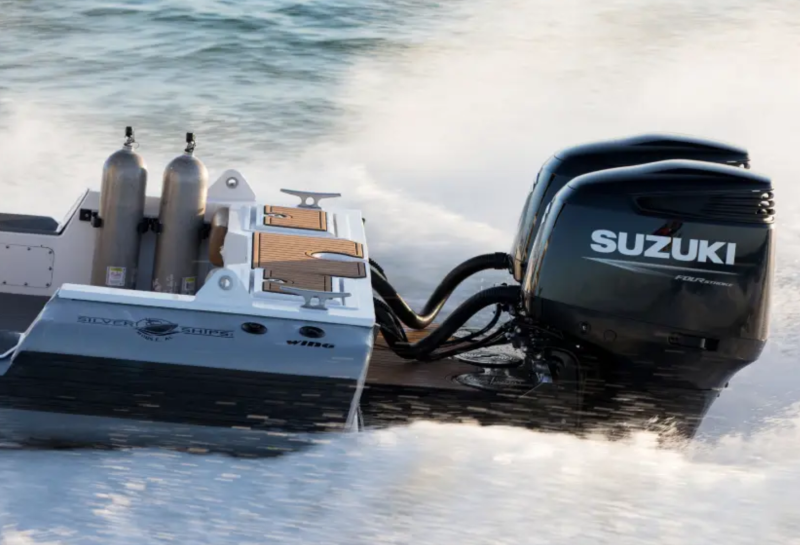
Suzuki has long built dependable, fuel-efficient four-strokes, with the top of the line now producing 350 hp. “Suzuki Selective Rotation” combines standard and counter-rotation operation into the same lower unit of these outboards. (Suzuki)
Planing Speeds
As the boat goes on plane, the drive should be trimmed out and the tabs raised until maximum mpg is achieved at a given rpm. This is generally between 3500 and 4000 rpm. Heavier boats might require 4500 rpm to get on plane.
Low torque. The reason why gas outboards need to run at high rpm to get on plane is that they don’t have much torque in the low and mid-rpm range. As the rpm increases gas outboards increase their torque. Heavier boats require more torque to get on plane, therefor need high horsepower, and multiple engines.
In small boats, adjusting weight forward, away from the stern, can make planing quicker—moving a couple of passengers from the stern seats to the bow, for example. Just remember, once the boat planes, more weight up front will make it tend to plow, which cuts fuel economy—and can result in “bow steering”.
Smart boaters will find the planning speed which is both the most fuel efficient and the most comfortable.
Fuel use increases rapidly above 5000 rpm for most boats. The engines are being run nearer their design limits so internal heat and friction increase, and wind drag also becomes a factor in most boats as they reach higher speeds.
However, a few high-performance boats that ride on small pads near the transom do deliver fuel economy that’s a match for their cruising speed when fully trimmed, and props maximizing pitch efficiency and and running at or near red line rpm.
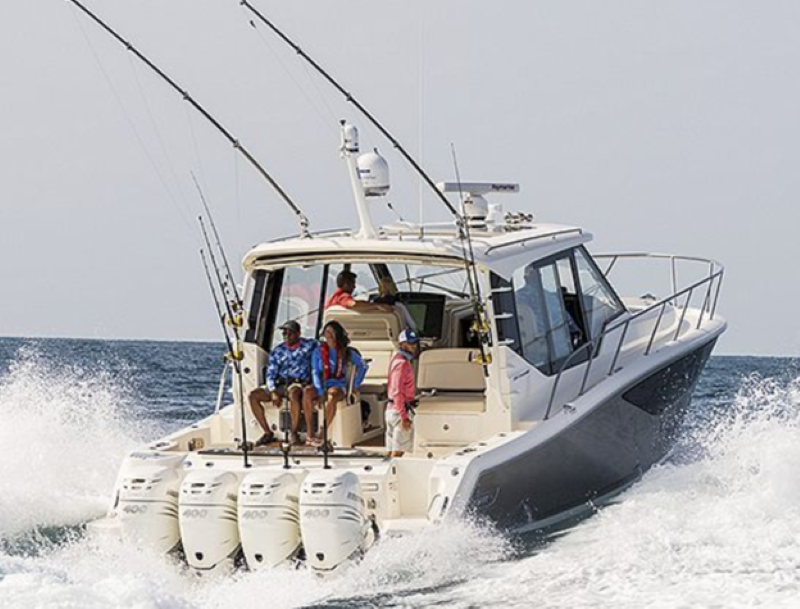
1600-hp is what it takes to get large cruising boats on plane and producing reasonable speeds in the mid to high 40s for some boats. (Boston Whaler)
Other Factors Affecting MPG
While a car generally gets the same mileage wherever you drive it (excepting perhaps on mountain roads) boat mpg depends on a number of factors.
The hull design, whether it’s a planing hull, displacement hull, catamaran or even a hydro-plane is the major factor. The running draft, the beam and shape of the hull and of course the sea conditions and wind all have a major impact.
10 Ways to Maximize MPG
- Keeping the bottom of your boat clean and free of marine growth is a must for maximum fuel economy. Don't assume that a little harmless, soft scum on the bottom of your boat won't hurt your fuel efficiency. It will to a surprising degree.
- Run the right pitch prop for your application. Unfortunately, you can't always rely on the builder or the dealer to deliver a new boat with the right prop for your needs. Do research, talk to a prop tech, and read Boat TEST's prop tutorials in its "Prop Shop" library section.
- Make sure your prop is balanced and has no dings or imperfections. Make sure there are no pits where the blade meets the hub. Small imperfections will cause drag and higher fuel consumption.
- Be sure you have followed the engine maker's scheduled maintenance. Clean, fresh plugs enhance ignition, clean air filters maximize air sucked into the cylinders, and changing oil every 100 hours insures best lubrication and the least friction, and the same goes for lube in the gears.
- Eliminate needless weight. Boats tend to accumulate stuff, and that's one reason why older boats get heavy and lose their new-boat mpg efficiency. Take everything off not really needed. Watch your fuel level. If you have a 100-gallon tank and only need 30 gallons for your weekend activities, 50 gallons in the tank should be enough -- that will save you 300 lbs., and you'll burn less fuel.
- Use engine-makers' recommended fuel octane. Do not use E-fuel. E-10 has about 120,000 BTU, compared to 125,000 BTU for regular gas -- about 4% less energy.
- Make sure engine trim setting is optimal. This is important and can make a big difference in fuel economy. Trim tabs should be up when on plane, except to keep the boat on an even keel.
- Reduce wind resistance, if possible. Windage makes it harder for your engine to perform it's job and the faster you go the greater the negative affect on fuel economy.
- With older engines, we recommend that the engine be serviced by a mechanic qualified on the brand engine you have. Incorrect spark timing, a fuel injection system that has gotten out of calibration, partial blockage in the exhaust system causing increased back pressure, and other details all will reduce mpg.
- Make sure that your engine is at the proper height on your transom. The anti-cavitation plate should be just below the bottom of your boat so that when on plane your prop is totally submerged and the cavation plate is at or just below the surface.